Do You Really Need 32 Cores?
The arms race between AMD and Intel finds the companies regularly increasing the number of cores for their respective lineups. AMD fired the first salvo in recent years on the high end desktop with its first-gen Threadripper products (like the flagship 1950X) that set a new high watermark of up to 16 cores, but Intel returned fire with the beefy 18-core Skylake-X 7980XE. Those hefty processors came bearing stratospheric prices and already push far beyond the necessary for all but the most intense users. But now AMD has escalated the battle with the second-generation Threadripper chips like the 32-core, 64-thread Threadripper 2990WX and 2950X, the latter with “just” 16 cores and 32 threads.
The new processors are impressive halo products, and while they appeal to our desire for more of everything, lots of software isn't yet optimized for massive multi-core processors.
Do you want 32 cores? Yes. But do you really need them? Well, that depends. Let’s investigate.
Productivity
Productivity applications are the real target for Intel's Skylake-X and AMD's Threadripper processors. These chips straddle the line between professional workstation-class products, like Intel's Xeon W and AMD’s EPYC lines, and the upper end of the desktop PC stack. AMD's processors also support ECC memory, which detects and corrects errors automatically to help ensure data integrity, further cementing the value for professionals and semi-professionals.
AMD splits its new Threadripper 2 processors into X and WX families. The X models like the 2950X come with up to 16 cores and 32 threads and are designed for enthusiasts and gamers. The WX models stretch up to 32 cores and 64 threads and appeal to "creatives" and "innovators," like the streamers and video producers of the world. Intel positions its Skylake-X processors for all types of applications.





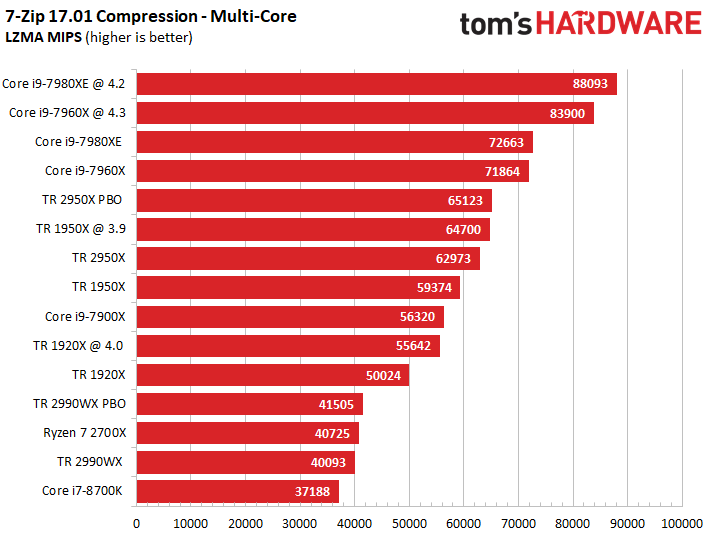
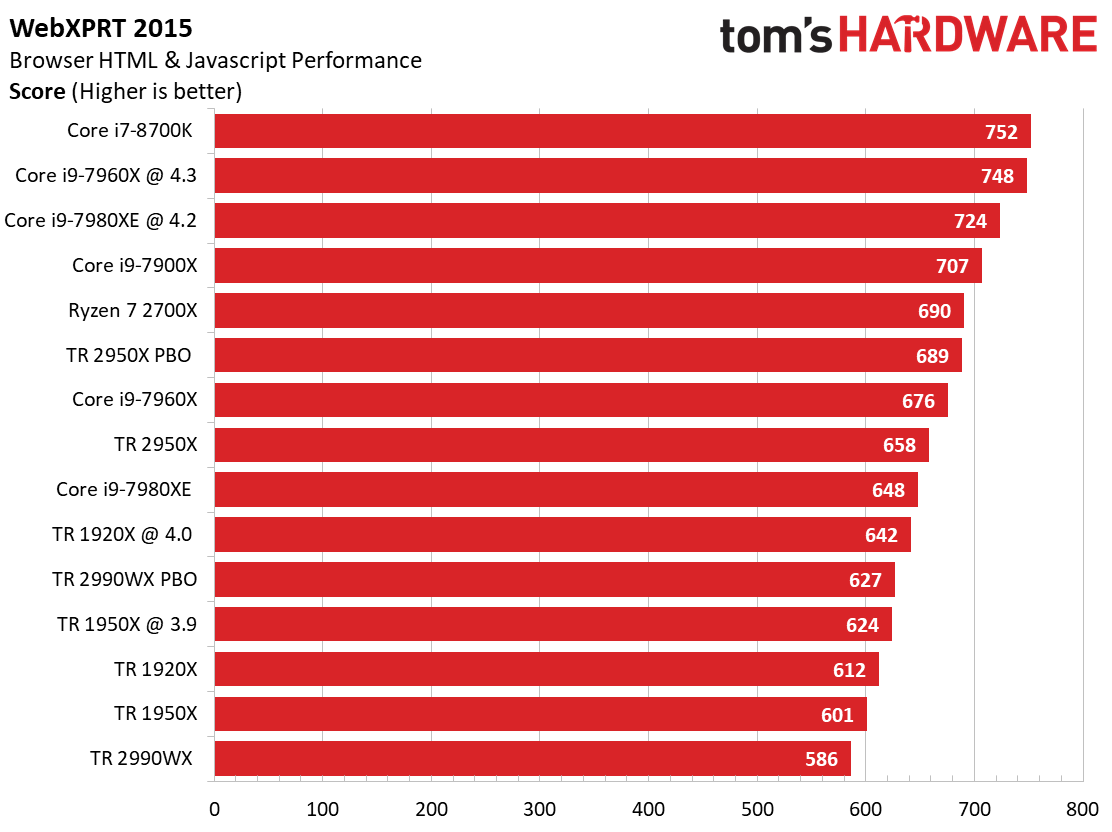











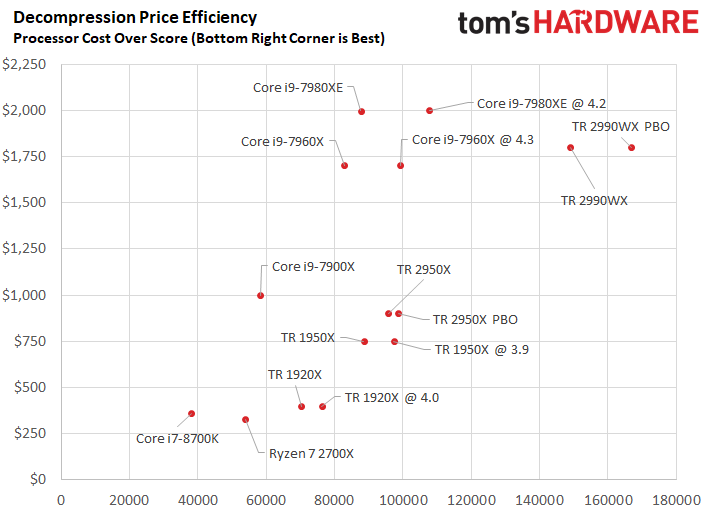


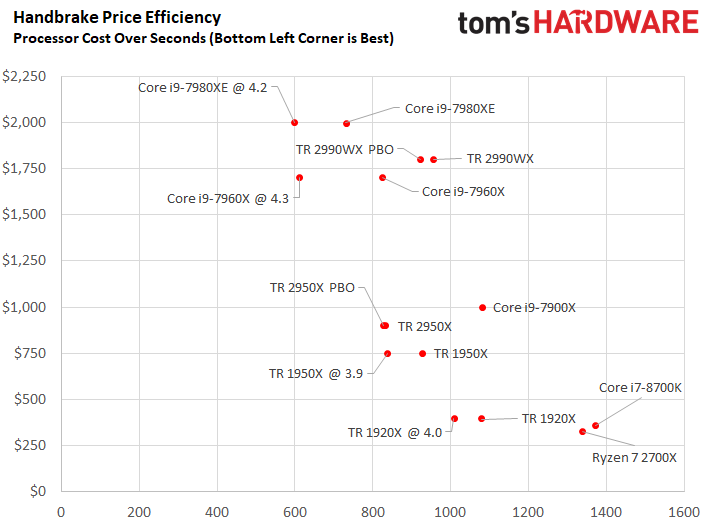

Applications generally segment into two categories: applications that respond best to per-core performance, which is a mixture of IPC (Instructions per Cycle) and frequency, and parallelized applications that can leverage the full multi-threaded heft of processors with high core counts. Other factors, such as memory and cache throughput and latency, also have varying levels of importance with different workloads.
As we can see, the Threadripper X-series processors generally perform best in multi-threaded applications and offer acceptable (though not excellent) performance in lightly-threaded applications, while Intel's lineup excels at lightly threaded workloads but also responds well to highly threaded tasks.
Get Tom's Hardware's best news and in-depth reviews, straight to your inbox.
The impact of more cores in threaded workloads, like rendering, compression/decompression, ray tracing, and video processing, is nothing short of explosive, regardless of the company producing those cores. POV-Ray, a ray tracing application, and CineBench, a 3D content creation program, are good examples of workloads that scale well with the addition of more processing cores. The speed-up in time-intensive tasks is worth every penny for professionals and semi-professionals alike. The extra cores also facilitate using multiple resource-intense applications simultaneously, which again boosts productivity.
Most lightly-threaded tasks, like basic office software, web browsers, and Adobe’s software suite, continue to perform better on mainstream desktop processors, which tend to feature fewer cores, but higher clock speeds. But the high-end, high-core-count processors still offer more than acceptable levels of performance in these tasks, so you don't have to make serious trade-offs in those types of applications to access the benefits of core-heavy processors.
AMD's WX-series processors, which includes the 32-core 64-thread 2990WX, fall into their own unique category. Aside from the industry-leading number of cores, the processors also have a totally unique design that involves some trade-offs. The WX chip design has a distributed memory architecture that leaves half of the cores stranded from local memory, which can lead to reduced performance scaling in some types of applications.
In some workloads, like HandBrake, the 32-core beast only provides small advantages over its 16-core counterparts. Our HandBrake x264 and x265 tests use AVX instructions, with the latter employing a heavier AVX distribution to further boost performance. The 2990WX doesn’t provide a big boost in either workload compared to the 2950X. Many common streaming applications, like OBS, use x264 for streaming. That means the 2990WX’s performance advantages for game streamers, at least in relation to the 2950X, could be slight. We also see the same trend in our y-cruncher test, which computes pi using AVX instructions. Many common productivity applications utilize these types of operations, making the reduced AVX scaling a problematic for some professional workloads.
The 32-core 2990WX also lags its competitors in lightly-threaded applications, like web browsers and our Adobe test suite.
But where AMD’s top-end Threadripper chip shines, it really shines. Heavy multi-threaded applications like rendering, decompression, and ray tracing see massive performance gains that easily dwarf the competition. This product serves a very specific niche of the workstation segment, but it can offer tangible benefits if your workload can exploit the extreme parallelism.
Gaming
AMD doesn't specifically target the gaming market with its higher-end WX series chips, instead cutting its gaming recommendation off at the 16-core 32-thread Threadripper 2950X. Conversely, Intel recommends its competing Skylake-X models, which feature up to 18 cores, for gaming and other types of applications. That means Intel defines the cutoff point for gaming at 18 cores, which also happens to be the highest core count in the company's desktop product stack.
Unfortunately for both companies, most game titles respond best to lightly-threaded performance, meaning that very few processor cores are actually active while you play most popular titles. Higher core count processors tend to have lower overall frequencies due to thermal limitations, which leads to lower performance in some game titles than you’d get with a mainstream chip like the Core i7-8700K or the Ryzen 7 27000X.
AMD's mission to boost the average number of cores has led more developers to optimize game engines for higher core counts, but the reality is that most games still perform best on mainstream processors that top out at eight cores. Our recent experimentation reveals that game engines alone do not bear all of the blame for mediocre performance gains--or in some cases reduced performance--that stem from processors with extreme core counts.








A recent report from Golem.de outlined abnormal performance regressions with Nvidia video cards paired with AMD's new 32-core Threadripper 2990WX. We updated a test system to the latest version of Windows and the newest graphics drivers from AMD and Nvidia to see if we could replicate the results. Here we can see that the Nvidia GeForce 1080 FE paired with a 16-core Threadripper 2950X, which we've effectively turned into an eight-core processor by toggling AMD's game mode, beats the RX Vega 64 in most game titles, like Grand Theft Auto V, Project CARS 2, Hitman, and Warhammer 40K: Dawn of War III.
That's expected. However, running the same tests with the full heft of the 32-core Threadripper 2 2990WX unveils some interesting performance regressions with the Nvidia card that allow AMD’s Vega card to take an abnormally large lead. We aren't sure of the root cause of these performance regressions. The odd tendencies don't impact all titles, but we have pinged Nvidia for comment. Regardless, this highlights that both drivers and game engines need more optimization to exploit the sheer grunt power of these multi-core beasts, particularly when they are used in tandem with AMD's unique architecture on the WX-series chips.



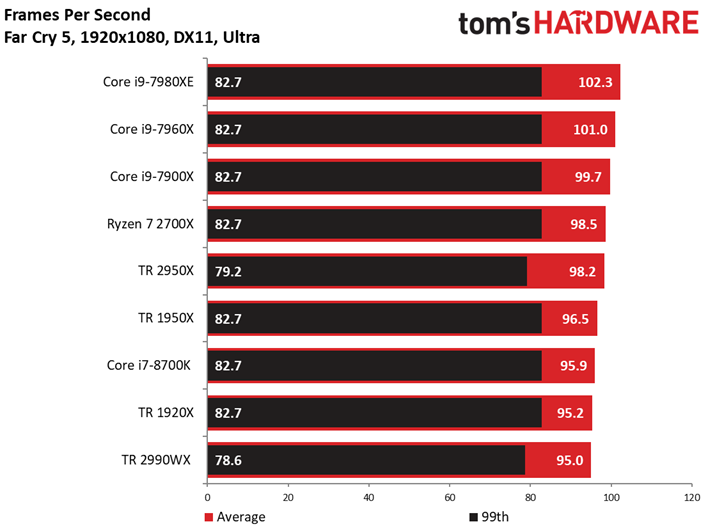








Zooming out to a broader set of processors reveals that models with heavy core counts do not perform as well as the less-expensive mainstream processors. Our first two slides contain a geometric mean of frame rates for all of the games in our standard test suite. We split these values into average frame rates and 99th-percentile frame rates, with the latter being a good indicator of the smoothness of your gaming experience. The remainder of the slides contain the results of each test.
We tested all Threadripper models with AMD's recommended "game mode," which essentially transforms them into eight-core sixteen-thread processors. AMD recommends reducing the Threadripper processors' core count because of excessive memory latency borne of the multi-chip module design. This indicates that AMD knows higher core counts don't benefit most game titles.
AMD isn’t alone here, though. The $2,000 Core i9-7980XE lags the $360 Core i7-8700K in the 99th percentile frame rate measurements. Sure, the Core i9-7980XE leads by 1.6 FPS in average frame rates, but you have to pay an extra $1,640 for a negligible performance advantage--and that's before we take the higher costs of X299 motherboard costs into account.
We see the same trend with AMD's eight-core Ryzen 7 2700X. At stock settings, this $329 processor handily dispatches its beefier $1,800 Threadripper 2990WX and $900 2950X counterparts.
Do You Need 32 Cores?
The extra cores from AMD and Intel could come in handy for streamers and heavy multitaskers during gaming sessions, but we don't recommend high-end desktop (HEDT) processors for most gamers. You can achieve better performance with mainstream processors and save well over $1000 in the process. Doing so leaves money in your build budget for high-performance parts that will provide performance boosts you can see and feel, like a faster GPU and / or SSD.
All that said, we can’t overstate the advantage of more cores in some productivity applications. If you regularly edit videos, large batches of photos, or do rendering work, the extra cores equate to much less time spent waiting on workloads to complete. That, in turn, allows you to move on to the next task faster. However, some of the most popular creative apps, including Adobe's entire lineup, don't support this amount of threads.
The 32-core Threadripper 2990WX is nothing short of phenomenal in workloads that can utilize its arsenal of execution cores. Rendering is a good example. But it doesn't scale well in many other applications. Unless you have very specific workloads that can utilize the power of 32 cores paired with its unique memory layout, it is best to stick with a more reasonable helping of cores.
For now, the rational cutoff point for most users focused on productivity applications or extreme multitasking lands at 18 cores for Intel models and 16 cores for AMD processors. The big issue there is pricing, with Intel’s Core i9-7980XE selling for close to $2,000. AMD’s competing Threadripper 2950X, while not quite available yet as of this writing (it’s expected to ship on August 31st), has a much more reasonable MSRP of $899.
MORE: AMD Ryzen Threadripper 2 vs. Intel Skylake-X: Battle of the High-End CPUs
MORE: Best CPUs
MORE: Intel & AMD Processor Hierarchy

Paul Alcorn is the Editor-in-Chief for Tom's Hardware US. He also writes news and reviews on CPUs, storage, and enterprise hardware.
-
zebarjadi.raouf ReplyDo you want 32 cores?
No, each core would be weaker compared to a consumer grade CPU like i7. But it would wipe the floor with i7 when doing multitasking. So it's a no when using it for core limited things like gaming.
But do you really need them? Well, that depends.
For games, more than 6 cores are not needed. 4 for the game, 2 for windows + streaming + etc. The 4 might change to 6 with new game engines optimization and better DX12/Vulkan support.
For a workstation, Yes. Time is money. The 32 core 2990WX is 266% (5.2x) better at multitasking than an 8700k and is 4.5x more expensive. I'm rounding the numbers here.
8700K > 400$ > 365 days to calculate
2990WX> 1800$ > 70 days to calculate
That means you would save 295 days for spending 1400$ more. Companies would spend more if it would make it faster even faster. They are competing for time with each other.
As I said before, it's also 30% weaker at just 4 core usage. For home use, a consumer version is enough.
http://cpu.userbenchmark.com/Compare/Intel-Core-i7-8700K-vs-AMD-Ryzen-TR-2990WX/3937vsm560423 -
zebarjadi.raouf Reply
It's not that simple, you would have known if you were a game developer.21258414 said:What we need are game developers to start taking advantage of multi-threading...
I dabbled in Unity, Unreal, C++ and other programming/gaming related stuff before. It's very time consuming to implement and optimize multi-threading. They are not working for free, they are on a time and money budget.
The newer games had performance drop or crashed when they were used with DX12/vulkan API due to the optimization and updates needed. But now they offer improvements over older API.
Ashes of the Singularity and Rise of the Tomb Raider is popular for DX12 with DOOM for Vulkan. -
bigdragon The real question is "Do you really need more than 4 cores?" The obvious answer is yes. 8 should be the absolute minimum these days. It's time to stop letting Intel hold everyone back on 4 cores for desktop and 2 cores for mobile.Reply -
BulkZerker "The extra cores from AMD and Intel could come in handy for streamers and heavy multitaskers during gaming sessions, but we don't recommend high-end desktop (HEDT) processors for most gamers."Reply
The only current need for a gamer to use a chip with that high of a core count is they are using the system as a decoding box for their stream (at 2k or 4k, bleeding edge stuff.) Recording the footage for an upload to YouTube, And also hosting a local server at the same time.
L1techs outputs their stream at 4k to twitch and it takes every last bit of an overclocked i7 5960 using an elgato capture card to encode the stream. They have made mention of switching to something with a higher core count
@bigdragon 8 threads, not 8 cores. Intel and AMD middy the waters by not having all chips support multithreading. If 8tureada offer 80% of the performance at half the price I'll push someone towards the cheaper chip every time because that are on a budget -
TerryLaze Reply21258674 said:The real question is "Do you really need more than 4 cores?" The obvious answer is yes. 8 should be the absolute minimum these days. It's time to stop letting Intel hold everyone back on 4 cores for desktop and 2 cores for mobile.
The i3-8350k at stock is barely 10% behind the 6c/12t 1600 when looking at a wide variety of different workloads,including all kinds from heavily multithreaded to medium and lightly ones.
That's not really what someone would call being held back.
https://www.techpowerup.com/reviews/AMD/Ryzen_7_2700/19.html -
anthony.preston I like the idea of being able to turn the 32 cores into a 8 core 4 thread machine. Core licensing is starting to become a major problem. Being able to run a single core with 4 threads would help reduce licensing costs!Reply -
zebarjadi.raouf ReplyThe i3-8350k at stock is barely 10% behind the 6c/12t 1600 when looking at a wide variety of different workloads,including all kinds from heavily multithreaded to medium and lightly ones.
You sure you did your calculations correctly? Blender doesn't agree. R5 1600 is 1.65x (40%) faster than 8350k.
https://www.techpowerup.com/reviews/AMD/Ryzen_7_2700/9.html
Nor does user bench agree. 72% faster at overall multi-core usage.
http://cpu.userbenchmark.com/Compare/Intel-Core-i3-8350K-vs-AMD-Ryzen-5-1600/3935vs3919
-
Martell1977 I wonder how long until they make a dual socket for these...64 cores/128 threads would truly be epic.Reply
But for my purposes...My i7-950 is plenty even today.


